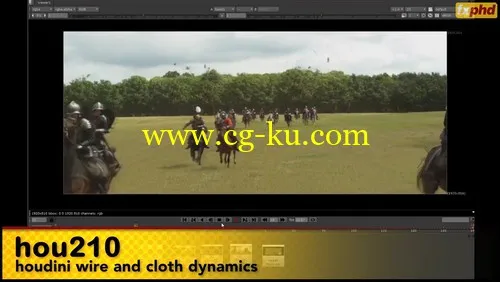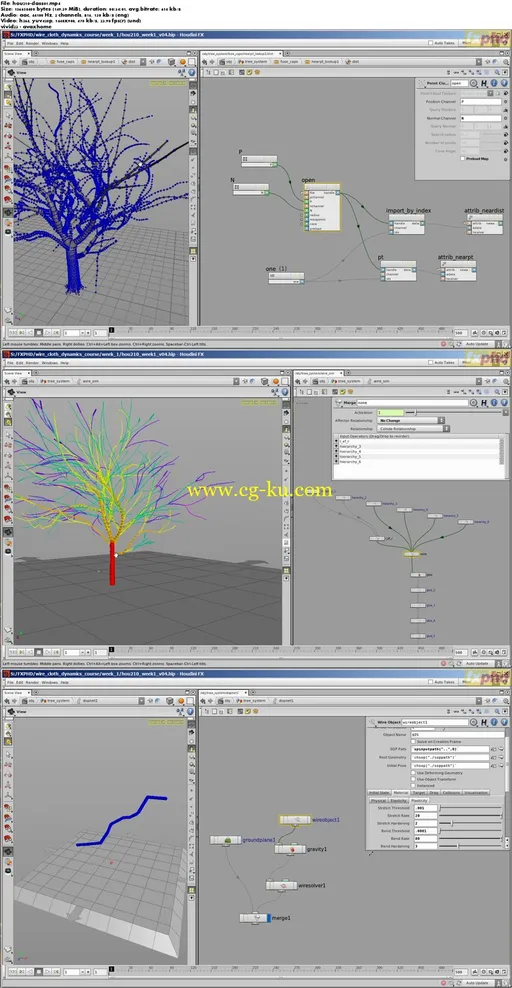
fxphd - HOU210: Houdini Wire and Cloth Dynamics
1440x900 | MP4/AVC1 @ 478 Kbps | Audio: English AAC @ 128 kbps | 2.41 GB
Genre: eLearning
Houdini has one of the most innovative, widely used, and extendable dynamics solutions of any 3D solution. The highly popular rigid body solutions and fluid/pyro simulation is relied on in many vfx studios FX pipelines. Wire and cloth simulation are very often underutilized in classic FX work, and often considered mainly for character FX such as hair and clothing. This course will show how wire and cloth simulation can add more realism in many situations involving non-character FX tasks. These workflows can both augment existing destruction workflows as well as enable the Houdini artist to take on many fun and out of the ordinary challenges.
More info
Through this course, we will explore FX relevant wire and cloth scenarios such as simulating trees, flags, and a complex metal destruction setup. Fundamental Houdini workflows such as attributes, transform matrix manipulation, and basic rbd and particle destruction will be enhanced with Houdini's simple and robust wire system as well as it's new, fast and very powerful cloth system.
Andrew Lowell is a Houdini FX artist on numerous films, spanning several years, countries, and studios. He's a perpetual generalist and his background includes music and mixing, compositing and video editing, and every generalist skill set in the vfx business; always taking on the hardest and weirdest FX tasks in production. He's also an experienced Houdini educator and author, and has developed many different methodologies for effectively teaching Houdini to both students and professionals.
class syllabus
Class 1: Wire basics. This class will go through wire simulation fundamentals including transform matrix and attribute manipulation. Various FX uses for cloth will also be discussed.
Class 2: Wire Forest part 1. In the first project of the course, we will use wires to simulate interaction with a forest as in "Jack the Giant Slayer." This will start with a tree and wire mesh. We will build a system to rig the tree using geometry operations.
Class 3: Wire Forest part 2. Here we will go through the bulk of the wire simulation process. Best practices of wire simulation will be covered, as well as how to make use of rigid body dynamics objects as colliders.
Class 4: Wire Forest part 3. In this course we will create a skin system using wires to deform tree meshes. Various logic and operations with geometry and deformation will be covered.
Class 5: Wire Forest part 4. We'll use various wire attributes to create a falling leaf system. Particle and matrix operations will also be explored.
Class 6: Cloth basics. Cloth properties will be addressed in depth. Uses and needs for cloth simulation both in and out of character effects will be discussed as well. We'll set up and simulate a basic flag to animation.
Class 7: Flag crowd. This lesson will dive a little deeper into cloth and go through a scenario with crowd delegates flying flags at a stadium as in "Invictus." Reference footage will be studied and matched with cloth properties and wind forces.
Class 8: Destruction with Cloth and Wires, part 1. This larger-scale project will involve the destruction of a bridge. Wires and cloth will be used to simulate various forms of destruction. Here we'll set up which objects will be simulated with wire/cloth and where constraints need to be placed.
Class 9: Destruction with Cloth and Wires, part 2. Here we'll test out various properties of different parts of the bridge to get the most realistic simulation.
Class 10: Destruction with Cloth and Wires, part 3. Now we'll tie various forces and parts of the bridge together with constraints for a complete simulation. Also add rigid body dynamics where necessary. We'll also finalize the shot with high quality deformation.

发布日期: 2014-06-26